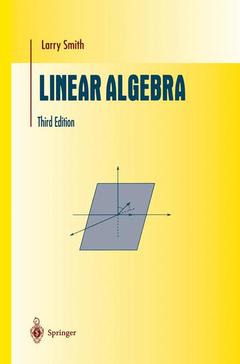Description
Linear Algebra (3rd Ed., Softcover reprint of the original 3rd ed. 1998)
Undergraduate Texts in Mathematics Series
Author: Smith Larry
Language: English
Subject for Linear Algebra:
Publication date: 10-2012
454 p. · 15.5x23.5 cm · Paperback
454 p. · 15.5x23.5 cm · Paperback
Description
/li>Contents
/li>
This popular and successful text was originally written for a one-semester course in linear algebra at the sophomore undergraduate level. Consequently, the book deals almost exclusively with real finite dimensional vector spaces, but in a setting and formulation that permits easy generalization to abstract vector spaces. A wide selection of examples of vector spaces and linear transformation is presented to serve as a testing ground for the theory. In the second edition, a new chapter on Jordan normal form was added which reappears here in expanded form as the second goal of this new edition, after the principal axis theorem. To achieve these goals in one semester it is necessary to follow a straight path, but this is compensated by a wide selection of examples and exercises. In addition, the author includes an introduction to invariant theory to show that linear algebra alone is incapable of solving these canonical forms problems. This bookis a compact but mathematically clean introduction to linear algebra with particular emphasis on topics in abstract algebra, the theory of differential equations, and group representation theory.
1. Vectors in the Plane and in Space.- 1.1 First Steps.- 1.2 Exercises.- 2. Vector Spaces.- 2.1 Axioms for Vector Spaces.- 2.2 Cartesian (or Euclidean) Spaces.- 2.3 Some Rules for Vector Algebra.- 2.4 Exercises.- 3. Examples of Vector Spaces.- 3.1 Three Basic Examples.- 3.2 Further Examples of Vector Spaces.- 3.3 Exercises.- 4. Subspaces.- 4.1 Basic Properties of Vector Subspaces.- 4.2 Examples of Subspaces.- 4.3 Exercises.- 5. Linear Independence and Dependence.- 5.1 Basic Definitions and Examples.- 5.2 Properties of Independent and Dependent Sets.- 5.3 Exercises.- 6. Finite-Dimensional Vector Spaces and Bases.- 6.1 Finite-Dimensional Vector Spaces.- 6.2 Properties of Bases.- 6.3 Using Bases.- 6.4 Exercises.- 7. The Elements of Vector Spaces: A Summing Up.- 7.1 Numerical Examples.- 7.2 Exercises.- 8. Linear Transformations.- 8.1 Definition of Linear Transformations.- 8.2 Examples of Linear Transformations.- 8.3 Properties of Linear Transformations.- 8.4 Images and Kernels of Linear Transformations.- 8.5 Some Fundamental Constructions.- 8.6 Isomorphism of Vector Spaces.- 8.7 Exercises.- 9. Linear Transformations: Examples and Applications.- 9.1 Numerical Examples.- 9.2 Some Applications.- 9.3 Exercises.- 10. Linear Transformations and Matrices.- 10.1 Linear Transformations and Matrices in IR3.- 10.2 Some Numerical Examples.- 10.3 Matrices and Their Algebra.- 10.4 Special Types of Matrices.- 10.5 Exercises.- 11. Representing Linear Transformations by Matrices.- 11.1 Representing a Linear Transformation by a Matrix.- 11.2 Basic Theorems.- 11.3 Change of Bases.- 11.4 Exercises.- 12. More on Representing Linear Transformations by Matrices.- 12.1 Projections.- 12.2 Nilpotent Transformations.- 12.3 Cyclic Transformations.- 12.4 Exercises.- 13. Systems of Linear Equations.- 13.1 Existence Theorems.- 13.2 Reduction to Echelon Form.- 13.3 The Simplex Method.- 13.4 Exercises.- 14. The Elements of Eigenvalue and Eigenvector Theory.- 14.1 The Rank of an Endomorphism.- 14.2 Eigenvalues and Eigenvectors.- 14.3 Determinants.- 14.4 The Characteristic Polynomial.- 14.5 Diagonalization Theorems.- 14.6 Exercises.- 15. Inner Product Spaces.- 15.1 Scalar Products.- 15.2 Inner Product Spaces.- 15.3 Isometries.- 15.4 The Riesz Representation Theorem.- 15.5 Legendre Polynomials.- 15.6 Exercises.- 16. The Spectral Theorem and Quadratic Forms.- 16.1 Self-Adjoint Transformations.- 16.2 The Spectral Theorem.- 16.3 The Principal Axis Theorem for Quadratic Forms.- 16.4 A Proof of the Spectral Theorem in the General Case.- 16.5 Exercises.- 17. Jordan Canonical Form.- 17.1 Invariant Subspaces.- 17.2 Nilpotent Transformations.- 17.3 The Jordan Normal Form.- 17.4 Square Roots.- 17.5 The Hamilton-Cayley Theorem.- 17.6 Inverses.- 17.7 Exercises.- 18. Application to Differential Equations.- 18.1 Linear Differential Systems: Basic Definitions.- 18.2 Diagonalizable Systems.- 18.3 Application of Jordan Form.- 18.4 Exercises.- 19. The Similarity Problem.- 19.1 The Fundamental Problem ofLinear Algebra.- 19.2 A Bit of Invariant Theory.- 19.3 Exercises.- A. Multilinear Algebra and Determinants.- A.1 Multilinear Forms.- A.2 Determinants.- A.3 Exercises.- B. Complex Numbers.- B.1 The Complex Numbers.- B.2 Exercises.- Font Usage.- Notations.
© 2024 LAVOISIER S.A.S.




